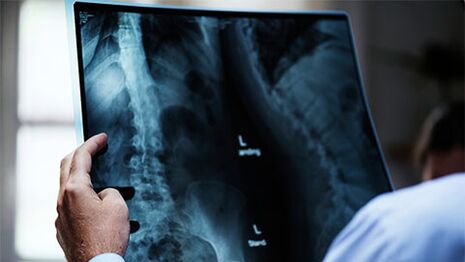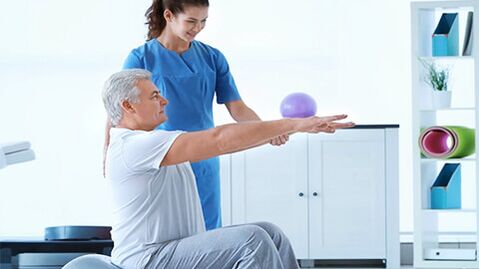
Back pain and numbness are symptoms that plague many people. The occasional occurrence of these unpleasant sensations can be due to a variety of reasons-prolonged inactivity, sitting for a long time or sleeping in the wrong posture. The persistence of this symptom indicates the development of degenerative dystrophic lesions of the spinal tissue-osteochondrosis.
Osteochondrosis: What?
Osteochondrosis is an extremely common disease, accounting for more than half of chronic back pain cases. As a result of a variety of factors (lack of nutrition in the diet, lack of physical activity, impaired metabolic processes in the body), the vertebrae and intervertebral discs and the tissue structure of the intervertebral discs began to undergo destructive changes. The bones and ligaments associated with it. This is reflected in their shape changes and reduced elasticity.
The vertebrae are compressed and the spine loses stability in the affected area. The nerve endings of the spinal cord are pinched, as a result, the back muscles have been in a hypertonic state. Due to the displacement of the vertebrae, the risk of herniation or intervertebral hernia as well as the risk of spondylosis (appearance of bony processes-osteophytes) is increased.
Types and stages of osteochondrosis
When diagnosing, the location of the degradation process should be considered. There are 4 types of osteochondrosis:
- waist
- chest;
- Cervical spine
- Widespread (when more than one department is affected).
Compared with other diseases, the diagnosis rate of lumbar osteochondrosis is higher because it is the cause of the upper body burden.
In the initial stage, osteochondrosis is hidden under the cover of local symptoms, which is why the patient is not treated in time and the disease continues to develop. The successive stages of development of the disease have the following characteristics:
- Displacement of the intervertebral disc and instability of the vertebrae.
- Due to the destruction of the annulus of the intervertebral disc (compression of the vertebrae), the intervertebral space is reduced.
- Deformation and herniation of the spinal cord or the appearance of intervertebral hernia due to the rupture of the annulus fibrosus and the herniated nucleus of the intervertebral disc, as well as the herniation of the intervertebral disc due to improper load on the intervertebral disc.
- The presence of bone growth (spondylosis), therefore, the spine loses its flexibility. The patient's movement is very difficult and causes severe pain and discomfort.
As with any disease, the earlier osteochondrosis is diagnosed, the better the chance of a successful cure. At the same time, after the condition is stable, lifelong prevention is needed to eliminate the risk of recurrence: exercise and special diet. Given that most modern people are at risk of developing this pathology, it is best to immediately develop healthy morning exercise habits.
Reasons for the development of osteochondrosis
Osteochondrosis is a more common disease in the elderly due to the natural causes of human aging and slowing down of metabolic processes. However, in the absence of physical exercise and a predominantly "fixed" lifestyle, this disease can develop in young people. In this case, the weakness of the back muscles can lead to the development of degenerative processes, thereby disrupting blood flow and nutrition of the vertebrae and intervertebral disc tissues.
Although popularOsteochondrosis, causeshisEmergency situationsNot yet fully understood. A variety of factors always lead to the development of the disease, including:
- Malformations of the nervous and musculoskeletal system, genetic factors; poor physical development;
- Violation of the human body's metabolic process, improper nutrient absorption, and interruption of endocrine and digestive system work;
- Lack of vitamins and minerals in the diet, unbalanced diet, and frequent dehydration;
- Long-term use of certain drugs;
- Excess weight and increased pressure on the spine, physical labor, and improper load distribution;
- A sedentary lifestyle, such as staying in an uncomfortable static position for long periods of time while working in an office;
- Spinal injury; transfer of infectious diseases, high pressure.
When it starts to degenerate due to the difficulty of nutrients entering the intervertebral disc and vertebral tissues, it is possible to talk about this disease with confidence. In this case, regeneration is completely impossible, and against the background of accompanying factors, the vertebrae and intervertebral discs are gradually destroyed. Due to the body's natural process of self-regulation, osteophytes appear on the vertebrae, which are spurs from bone tissue that seem to consolidate the intervertebral space. In this case, the flexibility of the spine will be lost, and exercise will bring pain and discomfort.
Disease symptoms
If there is general similarity, the different speciesOsteochondrosisThere are differentSymptoms and signs. . . This is due to the fact that depending on the location of the positioning, the sensation of pain will affect nearby organs and body parts due to the squeezing of blood vessels.
For lumbar osteochondrosis, lower back pain is characterized by sudden movement or staying in a static position for a long time. As a result of pinching nerve endings, one or both legs may experience pain. The nature of the pain varies from pain to ejaculation. By adopting a comfortable posture, the pain will disappear.
The second most common type of osteochondrosis is cervical spondylosis, which is characterized by the following symptoms: dull headache and dizziness. Head movement can exacerbate unpleasant feelings, and taking painkillers does not relieve pain syndrome. It can cause pain in the chest, which feels similar to an attack of angina, but lasts longer. In addition, the hands and fingers have numbness and sharp pain. It may be the numbness of the tongue, making it difficult to carry out verbal activities.
Chest chondropathy is relatively rare. The main reason for its development is the curvature of the spine, which is less injured. This type of disease is the most difficult to diagnose because its clinical signs are similar to other diseases. In addition to back pain (intensified with exercise and bending) and osteochondrosis of the thoracic spine, it can also cause pain in the heart, liver, and gastrointestinal area. There is numbness in the sternum muscles and weakened genital function.
Common osteochondrosis combines the signs of several types of osteochondrosis.
How is the diagnosis performed?

When diagnosing osteochondrosis, external examination of the patient is not enough. In addition to collecting data, neurologists or vertebral surgeons also prescribe the following types of examinations to clarify their nature and determine the extent of damage to the spine:
- X-ray
- Nuclear magnetic resonance;
- CT scan.
Make the final diagnosis based on the image results, and then select the appropriate treatment plan.
How to treat back osteochondrosis
Due toOsteochondrosisMultiple factors work togethertreatmentAlways include a whole set of measures. After the acute illness has been eliminated with the help of painkillers (if this is needed) and a balanced diet has been specified, the following recovery methods will be used:
- Exercise therapy is a type of physical therapy in which a series of exercises are designed to develop damaged areas of the spine and normalize muscle tone. At the same time, physical activity is restricted in order to strengthen the muscles of the back and restore the flexibility of joints and ligaments. Exercise therapy is considered to be the most effective way to treat osteochondrosis, but it should be carried out under the supervision of an expert. There are many areas of exercise therapy, including exercise therapy, health roads, and courses on special simulators. There are practically no restrictions on exercise therapy, because in most cases, each patient is assigned a separate set of exercises. You cannot take exercise therapy during the acute phase of the disease or severe spinal cord injury.
- Physiotherapy has complex procedures designed to relieve pain and stimulate the natural regeneration process of vertebrae and intervertebral disc tissues. They use the effects of laser, ultrasonic, and magnetic vibration. As another way to relax muscles, strengthen the body and restore the nervous system, acupuncture or pearl bath can be prescribed.
- Massage can relieve pain and restore blood circulation in the muscles. Massage is not used in the acute phase of the disease.
- Spinal traction or traction. During this process, the vertebrae return to their natural position, so the load on the spine becomes even.
- Reflexology, when used by a specialist, will act on the reflex area and pain points to relieve pain. It is used in conjunction with massage.
- Preventive measures that have a significant therapeutic effect include the use of special orthopedic equipment: mattresses, pillows, orthopedic shoes or insoles, and special corsets to support the damaged part of the spine in the correct position.
- The acceptance of chondroprotective agents has become an additional source of nutrition for damaged tissues. You should also include gelatin-based dishes in your diet: jelly, jelly meat, jelly.
- According to the doctor’s prescription and passing appropriate tests, foreign experts recommend taking vitamin D3, omega fatty acids and vitamin B complex.
What happens if osteochondrosis is not treated
If the treatment is not timely or correct, osteochondrosis can lead to the development of the following diseases:
- Vegetable vascular dystonia.
- Hypoxia in the brain.
- Intervertebral hernia can lead to impaired arm or leg motor function.
Prevention method
The prevention of osteochondrosis should aim to eliminate factors that increase the risk of its development. This mainly applies to people who have the following conditions:
- Genetic susceptibility to spinal diseases;
- Chronic diseases of the gastrointestinal tract, in which the absorption of nutrients is impaired;
- Diseases related to metabolic disorders;
- Severe infectious diseases, which spread during childhood;
- Spinal injury;
- Excess weight.
For sedentary people, the spine is under increasing pressure and women who plan to have children, prevention is very important.

The most important and easiest way to prevent osteochondrosis is moderate and regular physical exercise: gymnastics or swimming. You must monitor your posture and do not sit in unnatural positions for long periods of time. When sitting still for a long time, it is necessary to take a break and arrange physical exercise during this period-kneading the stiff muscles to restore blood circulation.
Usually, without considering the daily load of the spine, incorrect execution of daily habitual exercise will become a concomitant factor in the development of osteochondrosis. For example, you should avoid lifting weights and get rid of the habit of often putting heavy bags on the same shoulder. You cannot lift heavy objects from the floor from a standing position, you need to sit down first. When doing housework-cooking, cleaning, washing, placing it in the right place-stand and don't bend over.
Another secret is to wear comfortable shoes, preferably orthopedic or with orthopedic insoles. It is best to reject high heels altogether, or at least not to wear high heels all the time.



















